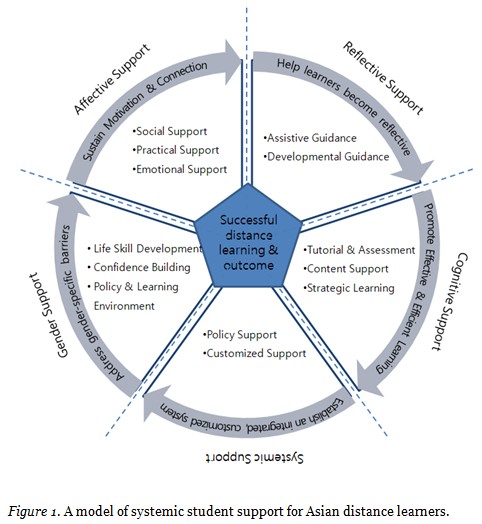
Published 2018-04-12
Keywords
- Asian distance education,
- distance learner support,
- quality assurance,
- student support
How to Cite
Abstract
Research indicates that distance education (DE) students regard learner support systems as the key element in quality provision. This study sought to identify the key concerns of Asian DE students regarding support provision in different types of DE and dual-mode providers and formulate a student support model which took account of gender issues. An online survey was conducted with 1,113 distance learners in Japan, Korea, Hong Kong SAR China, Malaysia, India, Pakistan, Philippines, Singapore, and Thailand which required them to respond to open-ended questions regarding their main concerns over the quality of distance education. Their responses were analyzed with Nvivo 2.0 based on the framework of the Atkins (2008) ARCS model of distance learner support. It was found that in assessing the quality of DE the students valued 13 types of student support across five domains: affective, reflective, cognitive, systemic, and gender-considerate. It was also confirmed that there were gender differences in the students’ perceptions of the need for student support. Building on these findings, an elaborated model for student support for Asian distance learners was developed from a systems perspective, and from this, a list of supporting strategies was proposed.
References
- Mishchenko TC. Epidemiology of cerebrovascular diseases and organization of assistance to patients with cerebral stroke in Ukraine. Ukrainian Psychoneurology Herald. 2017; 25(9):22-24. Publisher Full Text
- Zinchenko OM, Mishchenko TS. The state of the neurological service in Ukraine in 2015: a statistical and analytical guide. Kharkiv; 2016.
- American Heart Association. Heart Disease and Stroke Statistics—2017 Update: A Report From the American Heart Association. Circulation. 2017; 135:146-60. Publisher Full Text
- Harrisson RA, Field TS. Post stroke pain: identification, assessment and therapy. Cerebrovascular diseases. 2015; 39:190-201. DOI
- Cherenko T. Postnatal pain syndrome. Ukrainian Neurological Journal. 2014; 1:11-18.
- Hansen AP, Marcussen NS, Klit H, Andersen G, Finnerup NB, Jensen TS. Pain following a stroke: a prospective study. European Journal of Pain. 2012; 16(8):1128-1136. PubMedDOI
- Raghunathan S, Richard B, Khanna P. Causes and clinical features of headache in ischemic stroke. Progress in Neurology and Psychiatry. 2008; 12:21-23. DOI
- Dzhuzha TV, Fedorov SM, Gubenko VP. Pain musculoskeletal syndromes in older people: pathogenesis, clinic, therapeutic agents. Ternopil: Textbooks and manuals; 2017.
- Macheret EL, Korkushko AO. Basics of Traditional Chinese Medicine in Reflexology. Kiev: Action; 2005.
- Bossy Y. Bases for neurobiologiques des reflexotherapies. Paris: Masson; 1983.
- Kendall DE. A Scientific Model for Acupuncture. American Journal of Acupuncture. 1989; 17(3):251-268.

